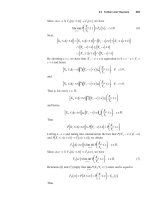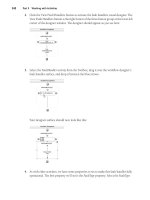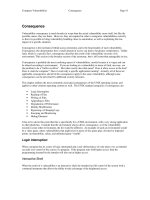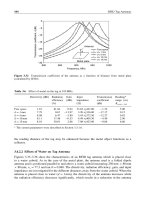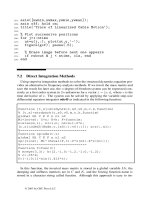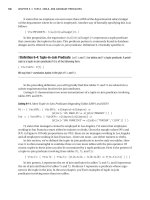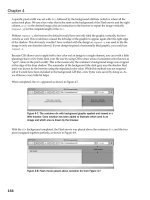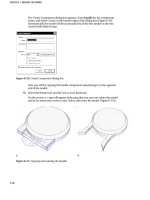concrete mathematics a foundation for computer science phần 5 pps
Bạn đang xem bản rút gọn của tài liệu. Xem và tải ngay bản đầy đủ của tài liệu tại đây (1.12 MB, 64 trang )
6
Special Numbers
SOME SEQUENCES of numbers arise so often in mathematics that we rec-
ognize them instantly and give them special names. For example, everybody
who learns arithmetic knows the sequence of square numbers
(1,4,9,16,
. . ).
In Chapter 1 we encountered the triangular numbers
(1,3,6,10,
. . . ); in Chap-
ter 4 we studied the prime numbers
(2,3,5,7,.
.
.);
in Chapter 5 we looked
briefly at the Catalan numbers
(1,2,5,14,
. . .
).
In the present chapter we’ll get to know a few other important sequences.
First on our agenda will be the Stirling numbers {t} and [L] , and the Eulerian
numbers
(i);
these form triangular patterns of coefficients analogous to the
binomial coefficients
(i)
in Pascal’s triangle. Then we’ll take a good look
at the harmonic numbers H,, and the Bernoulli numbers
B,;
these differ
from the other sequences we’ve been studying because they’re fractions, not
integers. Finally, we’ll examine the fascinating Fibonacci numbers F, and
some of their important generalizations.
6.1 STIRLING NUMBERS
We begin with some close relatives of the binomial coefficients, the
Stirling numbers, named after James Stirling (1692-1770). These numbers
come in two flavors, traditionally called by the no-frills names “Stirling num-
bers of the first and second kind!’ Although they have a venerable history
and numerous applications, they still lack a standard notation. We will write
{t} for Stirling numbers of the second kind and [z] for Stirling numbers of
the first kind, because these symbols turn out to be more user-friendly than
the many other notations that people have tried.
Tables 244 and 245 show what
{f;}
and [L] look like when n and k are
small. A problem that involves the numbers “1, 7, 6, 1” is likely to be related
to {E}, and a problem that involves
“6,
11, 6, 1” is likely to be related to
[;I,
just as we assume that a problem involving “1, 4, 6, 4, 1” is likely to be
related to (c); these are the trademark sequences that appear when n = 4.
243
244 SPECIAL NUMBERS
Table 244 Stirling’s triangle for subsets.
q mnni;)
Cl
(751
Cl
Cl
{aI
13
0
1
1
0 1
2
0 1
1
3
0 1
3
1
4
0 1
7 6
1
5
0 1 15 25 10
1
6
0 1 31 90 65 15
1
7
0 1 63
301
350
140 21 1
8
0 1
127 966
1701
1050
266 28 1
9
0 1 255 3025 7770 6951
2646 462 36
1
Stirling numbers of the second kind show up more often than those of
the other variety, so let’s consider last things first. The symbol {i} stands for
(Stirling
himself
the number of ways to partition a set of n things into k nonempty subsets.
For example, there are seven ways to split a four-element set into two parts:
~~~fi~d~~!
book
[281].)
{1,2,3IuI41,
u,2,4u31,
U,3,4IuI21,
12,3,4uUl,
{1,2IuI3,41,
Il,3ICJ{2,41,
u,4wv,3h
(6.1)
thus {i} = 7. Notice that curly braces are used to denote sets as well as
the numbers {t} . This notational kinship helps us remember the meaning of
CL
which can be read “n subset
k!’
Let’s look at small k. There’s just one way to put n elements into a single
nonempty set; hence
{
‘,‘}
= 1, for all n > 0. On the other hand
{y}
= 0,
because a O-element set is empty.
The case k = 0 is a bit tricky. Things work out best if we agree that
there’s just one way to partition an empty set into zero nonempty parts; hence
{i} = 1. But a nonempty set needs at least one part, so {i} = 0 for n > 0.
What happens when k
==
2?
Certainly {i} = 0. If a set of n > 0 objects
is divided into two nonempty parts, one of those parts contains the last object
and some subset of the first
n
-
1
objects. There are
2+’
ways to choose the
latter subset, since each of the first n
-
1 objects is either in it or out of it;
but we mustn’t put all of those objects in it, because we want to end up with
two
nonempty
parts. Therefore we subtract
1:
n
11
2
=
T-1
-
1
)
integer n > 0.
(6.2)
(This tallies with our enumeration of {i} = 7 =
23
-
1 ways above.)
6.1 STIRLING NUMBERS 245
Table 245 Stirling’s triangle for cycles.
n
0
1
2
c
3
4
5
6
7
8
9
1
0
0
0
0
0
0
0
0
0
1
1
2
6
24
120
720
5040
40320
1
3
1
11
6
1
50
35 10
1
274
225 85 15 1
1764 1624
735
175 21 1
13068 13132 6769 1960
322 28 1
109584 118124 67284 22449 4536 546 36 1
A modification of this argument leads to a recurrence by which we can
compute {L} for all k: Given a set of n > 0 objects to be partitioned into k
nonempty parts, we either put the last object into a class by itself (in
{:I:}
ways), or we put it together with some nonempty subset of the first n
-
1
objects. There are
k{n,‘}
possibilities in the latter case, because each of the
{
“;‘}
ways to distribute the first n
-
1 objects into k nonempty parts gives
k subsets that the nth object can join. Hence
{;1)
=
k{rrk’}+{EI:},
integern>O.
This is the law that generates Table 244; without the factor of k it would
reduce to the addition formula (5.8) that generates Pascal’s triangle.
And now, Stirling numbers of the first kind. These are somewhat like
the others, but
[L]
counts the number of ways to arrange n objects into k
cycles instead of subsets. We verbalize ‘[;I’ by saying “n cycle k!’
Cycles are cyclic arrangements, like the necklaces we considered in Chap-
ter 4. The cycle
can be written more compactly as ‘[A, B, C, D]‘, with the understanding that
[A,B,C,D] = [B,C,D,A] = [C,D,A,Bl =
[D,A,B,Cl;
a cycle “wraps around” because its end is joined to its beginning. On the other
hand, the cycle [A, B, C,
D]
is not the same as [A, B, D,
C]
or [D, C, B, A].
246 SPECIAL NUMBERS
There are eleven different ways to make two cycles from four elements:
“There are nine
and sixty ways
[1,2,31
[41,
[’
,a41
Dl
,
[1,3,41
PI
,
[&3,4 [II,
of constructing
[1,3,21
[41,
[’
,4,21
Dl
,
P,4,31
PI
,
P,4,31
PI,
tribal lays,
And-every-single-
P,21
[3,41,
[’
,31
P,
4 ,
[I,41
P,31;
one-of-them-is-
(W
rjght,”
hence
[“;I
= 11.
-Rudyard Kipling
A singleton cycle (that is, a cycle with only one element) is essentially
the same as a singleton set (a set with only one element). Similarly, a 2-cycle
is like a 2-set, because we have [A,
B]
=
[B,
A] just as {A, B} = {B, A}. But
there are two diflerent 3-cycles, [A, B,
C]
and [A, C,
B].
Notice, for example,
that the eleven cycle pairs in (6.4) can be obtained from the seven set pairs
in (6.1) by making two cycles from each of the 3-element sets.
In general,
n!/n
= (n 1) ! cycles can be made from any n-element set,
whenever n > 0. (There are n! permutations, and each cycle corresponds
to n of them because any one of its elements can be listed first.) Therefore
we have
n
[I
1
= (n-l)!, integer n > 0.
This is much larger than the value {;} = 1 we had for Stirling subset numbers.
In fact, it is easy to see that the cycle numbers must be at least as large as
the subset numbers,
[E]
3
{L}y
integers n, k 3 0,
because every partition into nonempty subsets leads to at least one arrange-
ment of cycles.
Equality holds in (6.6) when all the cycles are necessarily singletons or
doubletons, because cycles are equivalent to subsets in such cases. This hap-
pens when k = n and when k = n
-
1; hence
[Z] =
{iI}’
[nl:l]
=
{nil}
In fact, it is easy to see that.
[“n]
=
{II}
=
”
[nil]
=
{nnl}
= (I)
(6.7)
(The number of ways to arrange n objects into n
-
1 cycles or subsets is
the number of ways to choose the two objects that will be in the same cycle
or subset.) The triangular numbers (;) = 1, 3, 6, 10, . . . are conspicuously
present in both Table 244 and Table 245.
6.1 STIRLING NUMBERS 247
We can derive a recurrence for
[z]
by modifying the argument we used
for {L}. Every arrangement of n objects in k cycles either puts the last object
into a cycle by itself (in
[:::I
wa
s
or inserts that object into one of the [“;‘Iy )
cycle arrangements of the first n- 1 objects. In the latter case, there are n- 1
different ways to do the insertion. (This takes some thought, but it’s not hard
to verify that there are j ways to put a new element into a j-cycle in order to
make a (j + 1)-cycle. When j = 3, for example, the cycle [A, B,
C]
leads to
[A,
B,
C,
Dl
,
[A,B,D,Cl,
or
[A,D,B,Cl
when we insert a new element D, and there are no other possibilities. Sum-
ming over all j gives a total of n- 1 ways to insert an nth object into a cycle
decomposition of n
-
1 objects.) The desired recurrence is therefore
n
[I
k
=
(n-l)[ni’]
+
[:I:],
integern>O.
This is the addition-formula analog that generates Table 245.
Comparison of (6.8) and (6.3) shows that the first term on the right side is
multiplied by its upper index (n- 1) in the case of Stirling cycle numbers, but
by its lower index k in the case of Stirling subset numbers. We can therefore
perform “absorption” in terms like n[z] and k{
T},
when we do proofs by
mathematical induction.
Every permutation is equivalent to a set of cycles. For example, consider
the permutation that takes 123456789 into 384729156. We can conveniently
represent it in two rows,
123456789
384729156,
showing that 1 goes to 3 and 2 goes to 8, etc. The cycle structure comes
about because 1 goes to 3, which goes to 4, which goes to 7, which goes back
to 1; that’s the cycle
[1,3,4,7].
Another cycle in this permutation is [2,8,5];
still another is
[6,91.
Therefore the permutation 384729156 is equivalent to
the cycle arrangement
[1,3,4,7l
L&8,51
691.
If we have any permutation
rr1
rrz
. . . rr, of
{
1,2,.
. . , n}, every element is in a
unique cycle. For if we start with mu = m and look at
ml
=
rrmor
ml
= rrm,,
etc., we must eventually come back to mk =
TQ.
(The numbers must re-
peat sooner or later, and the first number to reappear must be mc because
we know the unique predecessors of the other numbers ml,
ml,
. . . ,
m-1
.)
Therefore every permutation defines a cycle arrangement. Conversely, every
248 SPECIAL NUMBERS
cycle arrangement obviously defines a permutation if we reverse the construc-
tion, and this one-to-one correspondence shows that permutations and cycle
arrangements are essentially the same thing.
Therefore
[L]
is the number of permutations of n objects that contain
exactly k cycles. If we sum
[z]
over all k, we must get the total number of
permutations:
= n!, integer n 3 0.
(6.9)
For example, 6 + 11 + 6 + 1 = 24 = 4!.
Stirling numbers are useful because the recurrence relations (6.3) and
(6.8) arise in a variety of problems. For example, if we want to represent
ordinary powers
x”
by falling powers xc, we find that the first few cases are
X0
=
x0;
X1
zz
x1;
X2
zz
x2.+&
x3
=
x3+3&+,1;
X4
=
x4+6x3+7xL+x1,
These coefficients look suspiciously like the numbers in Table 244, reflected
between left and right; therefore we can be pretty confident that the general
formula is
Xk,
integer n 3 0.
(6.10)
We’d better define
{C}
=
[;I
=
0
when k < 0 and
And sure enough, a simple proof by induction clinches the argument: We n 3
O.
have
x.
xk
= xk+l + kxk,
bec:ause
xk+l =
xk
(x
-
k)
;
hence
x.
xnP1
is
x${~;‘}x”
=
;,i”;‘}x”+;{“;‘}kx”
=
;,{;I;}x”‘Fj”;‘}kx”
=
;,(k{“;‘}
+
{;;;;})xh
=
6
{;}xh.
In other words, Stirling subset numbers are the coefficients of factorial powers
that yield ordinary powers.
6.1 STIRLING NUMBERS 249
We can go the other way too, because Stirling cycle numbers are the
coefficients of ordinary powers that yield factorial powers:
xiT
= xo.
Xi =
xiI
xi
= x2 + x’ ;
x”
-
x3
+3x2 +2x';
x"
:
x4
+6x3 +11x* +6x'.
We have (x+n-
l).xk
=xk+’
+ (n
-
1 )xk, so a proof like the one just given
shows that
-
(xfn-1)~~~’
=
(x+n-1);
ril]xk
=
F
[r;]xk.
This leads to a proof by induction of the general formula
integer n 3 0.
(6.11)
(Setting x = 1 gives (6.9) again.)
But wait, you say. This equation involves rising factorial powers
xK,
while
(6.10) involves falling factorials xc. What if we want to express
xn
in terms of
ordinary powers, or if we want to express
X”
in terms of rising powers? Easy;
we just throw in some minus signs and get
integer n > 0; (6.12)
(6.13)
This works because, for example, the formula
x4
=
x(x-1)(x-2)(x-3)
= x4-6x3+11x2-6x
is just like the formula
XT =
~(~+1)(~+2)(x+3)
= x4+6x3+11x2+6x
but with alternating signs. The general identity
x3
=
(-ly-#
(6.14)
of exercise 2.17 converts (6.10) to (6.12) and (6.11) to (6.13) if we negate x.
250 SPECIAL NUMBERS
Table 250 Basic Stirling number identities, for integer n > 0.
Recurrences:
{L}
=
kjnk’}+{;I:}.
n
[I
k
=
(n-
Special values:
{I}
=
[i]
1
=
q [n =
01
.
n
{I
1
=
[n>Ol;
n
{I
2
=
(2np'
-1)
[n>O];
{nnl}
=
[n”l]
=’
(1)’
{;} = [j =
(;)
= 1.
{;} =
[;I
=
(3
=
0,
=
(n-l)![n>O].
n
[I
2
=
(n-l)!H,-1
[n>O]
if k > n.
Converting between powers:
X
ii
=T-
L
k
Inversion formulas:
n
k
1
Xk
.
(-l)“pk
II
[m=n];
6.1 STIRLING NUMBERS 251
Table 251 Additional Stirling number identities, for integers 1, m, n 3 0.
{Z}
=
$(i){k}.
[zl]
=
G
[J(k).
{;}
=
;
(;){;‘t:J(w”.
[;I
=
&
[;I;]
($J-k.
m!{z}
=
G
(3kn(-1) k.
{:I:}
=
&{L)(-+llnek.
[;;:I
=
f.[#~
=
&[j/k!.
{m+;+‘}
=
g
k{n;k}.
[m+:“]
=
g(n+k)[nlk].
(;)
=
F(nk++:}[$-li'"*.
In-m)!(Jh3ml
=
F
[;+':]{k}(-l)mek.
{n:m}
=
$
(ZZ)
(:I;)
[“:“I
*
[n:m]
=
~(Z~L)(ZI;)(-:“}
{lJm}(L:m)
=
G{F}{“m”)(L)
(6.15)
(6.16)
(6.17)
(6.18)
(6.19)
(6.20)
(6.21)
(6.22)
(6.23)
(6.24)
(6.25)
(6.26)
(6.27)
(6.28)
(6.29)
252 SPECIAL NUMBERS
We can remember when to stick the
(-l)“pk
factor into a formula like
(6.12) because there’s a natural ordering of powers when x is large:
Xii >
xn
>
x5,
for all x > n > 1.
(6.30)
The Stirling numbers
[t]
and {z} are nonnegative, so we have to use minus
signs when expanding a “small” power in terms of “large” ones.
We can plug (6.11) into (6.12) and get a double sum:
This holds for all x, so the coefficients of x0, x1, . . . , xnp’, x”+‘, xn+‘, . . on
the right must all be zero and we must have the identity
;
0
N
(-l)“pk
==
[m=n],
integers
m,n
3 0.
Stirling numbers, like b.inomial coefficients, satisfy many surprising iden-
tities. But these identities aren’t as versatile as the ones we had in Chapter 5,
so they aren’t applied nearly as often. Therefore it’s best for us just to list
the simplest ones, for future reference when a tough Stirling nut needs to be
cracked. Tables 250 and 251 contain the formulas that are most frequently
useful; the principal identities we have already derived are repeated there.
When we studied binomial coefficients in Chapter 5, we found that it
was advantageous to define
1::)
for negative n in such a way that the identity
(;) =
(“,‘)
+
(;I:)
.
IS
valid without any restrictions. Using that identity to
extend the (z)‘s beyond those with combinatorial significance, we discovered
(in Table 164) that Pascal’s triangle essentially reproduces itself in a rotated
form when we extend it upward. Let’s try the same thing with Stirling’s
triangles: What happens if we decide that the basic recurrences
{;}
=
k{n;‘}+{;I:}
n
[I
k
=
(n-I)[“;‘]
+
[;I:]
are valid for all integers n and k? The solution becomes unique if we make
the reasonable additional stipulations that
{E}
=
[J
= [k=Ol and
{t}
=
[z]
=
[n=O].
(6.32)
6.1 STIRLING NUMBERS 253
Table 253 Stirling’s triangles in tandem.
n
{:5}
{_nq}
{:3}
{:2}
{:1}
{i}
{Y}
{I}
{3}
{a}
{r}
-5
1
-4 10 1
-3 35 6 1
-2 50 11 3 1
-1 24 6 2 1
1
0
000001
1
0 0 0 0 0 0 1
2
0 0 0 0 0 0 11
3
0 0 0 0 0 0 13 1
4
0 0 0 0 0 0 17 6 1
5
0 0 0 0 0 0 115 25 10 1
In fact, a surprisingly pretty pattern emerges:
Stirling’s triangle for cycles
appears above Stirling’s triangle for subsets, and vice versa! The two kinds
of Stirling numbers are related by an extremely simple law:
[I]
=
{I:},
integers k,n.
We have “duality,” something like the relations between min and max, between
1x1
and
[xl,
between
XL
and
xK,
between gcd and lcm. It’s easy to check that
both of the recurrences
[J
= (n- 1) [“;‘I +
[i;:]
and
{i}
=
k{n;‘}
+
{:I:}
amount to the same thing, under this correspondence.
6.2
EULERIAN
NUMBERS
Another triangle of values pops up now and again, this one due to
Euler
[88,
page
4851,
and we denote its elements by (E). The angle brackets
in this case suggest “less than” and “greater than” signs; (E) is the number of
permutations
rr1
rr2
. . .
rr,
of
{l
,2, . . . ,
n} that have k ascents, namely, k places
where
Xj
< nj+l. (Caution: This notation is even less standard than our
no-
tations
[t]
,
{i}
for Stirling numbers. But we’ll see that it makes good sense.)
For example, eleven permutations of
{l
,2,3,4}
have two ascents:
1324, 1423, 2314, 2413, 3412;
1243, 1342, 2341;
2134, 3124, 4123.
(The first row lists the permutations with
~1
<
7~2
>
7r3
<
7~;
the second row
lists those with
rrl
<
~2
<
7~3
>
7~4
and
~1
>
rr2
<
713
<
7r4.)
Hence
(42)
= 11.
254 SPECIAL NUMBERS
Table 254 Euler’s triangle.
n
0
1
2
c
3
4
5
6
7
8
9
1
10
11
0
14
1
0
1
11 11
1
0
1
26
66. 26
1
0
1
57 302 302 57
1
0
1 120
1191
2416
1191
120
1
0
1 247 4293 15619
15619 4293
247 1 0
1 502 14608 88234 156190 88234 14608
502 1 0
Table 254 lists the smallest Eulerian numbers; notice that the trademark
sequence is
1,
11, 11, 1
this time. There can be at most n
-
1
ascents, when
n > 0, so we have
(:)
=
[n=:O]
on the diagonal of the triangle.
Euler’s triangle, like Pascal’s, is symmetric between left and right. But
in this case the symmetry law is slightly different:
(3
=
(,-Y-k),
integer n> 0;
(6.34)
The permutation
rrr
7~2
. . .
71,
has n- 1 -k ascents if and only if its “reflection”
7rn
*
. .
7r27rl
has k ascents.
Let’s try to find a recurrence for
(i).
Each permutation p =
p1
. . .
pnpl
of{l,
,n
-
1)
leads to n permutations of
{1,2,.
. .
,n}
if we insert the new
element n in all possible ways. Suppose we put n in position j, obtaining the
permutation
71
=
pi
. . .
pi-1
11
Pj
. . .
~~-1.
The number of ascents in
rr
is the
same as the number in
p,
if j = 1 or if
pi-1
<
pi;
it’s one greater than the
number in p, if
pi-1
>
oj
or if j = n. Therefore
rr
has k ascents in a total of
(kf
l)(n,‘)
Y
f
wa
s
rom permutations
p
that have k ascents, plus a total of
((n-2)-P-1)+1)(:X;)
ways from permutations
p
that have k- 1 ascents.
The desired recurrence is
(3
=
[k+lJ(n,l>+[n-k](LI:>.
integern>O.
(6.35)
Once again we start the recurrence off by setting
0
0
k
= [k=O], integer k,
(6.36)
and we will assume that
(L)
= 0 when k < 0.
6.2 EULERIAN NUMBERS 255
Eulerian numbers are useful primarily because they provide an unusual
connection between ordinary powers and consecutive binomial coefficients:
xn
=
F(L)(“L”>,
integern>O.
(This is “Worpitzky’s identity”
[308].)
For example, we have
x2
-
-
x3
=
(1)+(T))
(;)+qy)+(y’),
(;)+ll(x;')+11(Xfi2)+(X;3),
and so on.
It’s easy to prove (6.37) by induction (exercise 14).
Incidentally, (6.37) gives us yet another way to obtain the sum of the
first n squares: We have
k2
=
($(i)
+
(f)
(“i’) = (i) + (ki’), hence
12+22+ +n2
=
((;)+(;)+ +(;))+((;)+(;)+ +(";'))
=
("p)
+
("f2)
=
;(
n+l)n((n-l)+(n+2)).
The Eulerian recurrence (6.35) is a bit more complicated than the Stirling
recurrences (6.3) and
(6.8),
so we don’t expect the numbers
(L)
to satisfy as
many simple identities. Still, there are a few:
(t)
=
g
(n:‘)(m+l
-k)“(-llk;
-!{Z}
=
G(E)(n*m)’
(;)
=
$
{;}(“,“)(-l)nPk-mk!
(6.38)
(6.39)
(6.40)
If we multiply
(6.39)
by
znPm
and sum on m, we get
x,,
{
t}m! zn-“’ =
tk
(c)
(z
+ 1)
k.
Replacing
z
by
z
-
1 and equating coefficients of
zk
gives
(6.40). Thus the last two of these identities are essentially equivalent. The
first identity,
(6.38),
gives us special values when m is small:
(i)
= 1;
(I)
=
2n-n-l;
(1)
=
3”-(n+l)Z”+(n:‘) .
256 SPECIAL NUMBERS
Table 256 Second-order Eulerian triangle.
{'l
'I
L\‘,
0
1
/
2
3
4
5
6
7
8
1
10 1
_
J .f\
1 2
0
'1
i
I
!
18
6 0
1
/
i'
i
1 22
58 24
0
:
\I
'
1 52
328 444 120
0
1 114
1452 4400 3708 720
0
1 240
5610 32120 58140
33984 5040
0
1 494
19950 195800 644020 785304 341136 40320
0
We needn’t dwell further on
Eulerian
numbers here; it’s usually sufficient
simply to know that they exist, and to have a list of basic identities to fall
back on when the need arises. However, before we leave this topic, we should
take note of yet another triangular pattern of coefficients, shown in Table 256.
We call these “second-order Eulerian numbers”
((F)),
because they satisfy a
recurrence similar to (6.35) but with n replaced by 2n
-
1 in one place:
((E))
=
(k+l)((n~1))+(2n-l-k)((~-:)>.
(6.41)
These numbers have a curious combinatorial interpretation, first noticed by
Gessel and Stanley
[118]:
If we form permutations of the multiset
(1,
1,2,2,
. ,n,n} with the special property that all numbers between the two occur-
rences of m are greater than m, for 1 6 m 6 n, then ((t)) is the number of
such permutations that have k ascents. For example, there are eight suitable
single-ascent permutations of
{l
,
1,2,2,3,3}:
113322,
133221, 221331, 221133,
223311, 233211, 331122, 331221.
Thus
((T))
= 8. The multiset
{l,
1,2,2,.
.
. n}
, n,
has a total of
=
(2n-1)(2n-3) (l)
=
y
(6.42)
suitable permutations, because the two appearances of n must be adjacent
and there are 2n
-
1 places to insert them within a permutation for n
-
1.
For example, when n = 3 the permutation 1221 has five insertion points,
yielding
331221, 133221, 123321, 122331,
and
122133.
Recurrence (6.41) can
be proved by extending the argument we used for ordinary Eulerian numbers.
6.2
EULERIAN
NUMBERS 257
Second-order Eulerian numbers are important chiefly because of their
connection with Stirling numbers
[119]:
We have, by induction on n,
{x"n}
=
&(($~+n~lyk).
integern30;
(6.43)
[x”n]
=
g(~))(“~k)
7
For example,
{Zl}
=
(1))
integer n 3 0.
(6.44)
[x:1]
=
(1);
{z2}
=
(7’)
+2(g)
[x:2]
=
(:)+2(y);
(,r,}
=
(“:‘)
+8(y)
+6(d)
[xx3]
=
(1)
+8(x;‘)
+6(x12).
(We already encountered the case n = 1 in (6.7).) These identities hold
whenever x is an integer and n is a nonnegative integer. Since the right-hand
sides are polynomials in x, we can use (6.43) and (6.44) to define Stirling
numbers
{
.“,}
and [,Tn] for arbitrary real (or complex) values of x.
If n > 0, these polynomials
{
.“,} and
[,“J
are zero when x = 0, x =
1,
. . . ,
and x = n; therefore they are divisible by (x-O), (x-l), . . . , and (x-n).
It’s interesting to look at what’s left after these known factors are divided out.
We define the Stirling polynomials o,(x) by the rule
&l(x)
=
[
1
.",
/(X(X-l) (X-TX)).
(6.45)
(The degree of o,(x) is n
-
1.)
The first few cases are
So
l/x
isa
polynomial?
(Sorry
about
that.)
q)(x)
= l/x;
CT,(x)
=
l/2;
02(x)
=
(3x-1)/24;
q(x) =
(x2
-x)/48;
Q(X)
=
(15x3
-30x2+5x+2)/5760.
They can be computed via the second-order Eulerian numbers; for example,
CQ(X)
=
((~-4)(x-5)+8(x+1)(x-4)
+6(x+2)(x+1))/&
258 SPECIAL NUMBERS
Table 258 Stirline convolution formulas.
rs
f
Ok(T)
0,-k(S) = (r + s)on(r +
s)
k=O
(6.46)
S
f
k&(T) (T&(s) =
no,(r+
S)
(6.47)
k=O
rS&(l.+k)On&S-4-k)
= (?'+S)D,(l-+S+n)
k=O
n
SE
kCTk(T+k)G,~k(Si-
n-k) =
no,(r+S+n)
(6.48)
(6a)
k=O
=
(-l)""-l(mn!,),~"-,(m)
(6.50)
n
[
I
I
m
=
imT
,
)!
k,(n)
(6.51)
It turns out that these polynomials satisfy two very pretty identities:
zez
’
(
)
-
=
XpJ,(X)2Q
ez
-
1
TX>0
(iln&
=
x&o,(x+n)zn;
/
(6.52)
(6.53)
Therefore we can obtain general convolution formulas for Stirling numbers, as
we did for binomial coefficients in Table 202; the results appear in Table 258.
When a sum of Stirling numbers doesn’t fit the identities of Table 250 or 251,
Table 258 may be just the ticket. (An example appears later in this chapter,
following equation (6.100).
Elxercise
7.19 discusses the general principles of
convolutions based on identit:ies like (6.52) and (6.53).)
6.3 HARMONIC NUMBERS
It’s time now to take a closer look at harmonic numbers, which we
first met back in Chapter 2:
H,
=
,+;+;+ +;
=
f;,
integer n 3 0.
k=l
(6.54)
These numbers appear so often in the analysis of algorithms that computer
scientists need a special notation for them. We use
H,,
the ‘H’ standing for
6.3 HARMONIC NUMBERS 259
This must be
Table 259.
“harmonic,” since a tone of wavelength l/n is called the nth harmonic of a
tone whose wavelength is 1. The first few values look like this:
n101234
5 6 7 8 9 10
Exercise 21 shows that
H,
is never an integer when n > 1.
Here’s a card trick, based on an idea by R. T. Sharp
[264],
that illustrates
how the harmonic numbers arise naturally in simple situations. Given n cards
and a table, we’d like to create the largest possible overhang by stacking the
cards up over the table’s edge, subject to the laws of gravity:
To define the problem a bit more, we require the edges of the cards to be
parallel to the edge of the table; otherwise we could increase the overhang by
rotating the cards so that their corners stick out a little farther. And to make
the answer simpler, we assume that each card is 2 units long.
With one card, we get maximum overhang when its center of gravity is
just above the edge of the table. The center of gravity is in the middle of the
card, so we can create half a cardlength, or 1 unit, of overhang.
With two cards, it’s not hard to convince ourselves that we get maximum
overhang when the center of gravity of the top card is just above the edge
of the second card, and the center of gravity of both cards combined is just
above the edge of the table. The joint center of gravity of two cards will be
in the middle of their common part, so we are able to achieve an additional
half unit of overhang.
This pattern suggests a general method, where we place cards so that the
center of gravity of the top k cards lies just above the edge of the
k-t
1st card
(which supports those top k). The table plays the role of the
n+
1st card. To
express this condition algebraically, we can let
dk
be the distance from the
extreme edge of the top card to the corresponding edge of the kth card from
the top. Then
dl
= 0, and we want to make dk+, the center of gravity of the
first k cards:
&+l =
(4
+l)+(dz+l)+ +(dk+l),
for1
<k<n
k
\
, .
(6,55)
260 SPECIAL NUMBERS
(The center of gravity of k objects, having respective weights
WI,
. . . ,
wk
and having
reSpeCtiVe
Centers Of
gravity
at
pOSitiOnS
~1,
. . . pk, is at position
(WPl
+.
.
’
+
WkPk)/bl
+
’
’
. +
wk).)
We can rewrite this recurrence in two
equivalent forms
k&+1
= k +
dl
+ . . . +
dkp1
+
dk
,
k 3 0;
(k-l)dk
= k-l
+dl
+ +dk-1, k>
1.
Subtracting these equations tells us that
kdk+l
-(k-l)dk
=
1
+dk,
k>
1;
hence dk+l = dk + l/k. The second card will be offset half a unit past the
third, which is a third of a unit past the fourth, and so on. The general
formula
&+I
=
Hk
(6.56)
follows by induction, and if we set k = n we get dn+l =
H,
as the total
overhang when n cards are stacked as described.
Could we achieve greater overhang by holding back, not pushing each
card to an extreme position but storing up “potential gravitational energy”
for a later advance? No; any well-balanced card placement has
&+I 6
(l+dl)+(l-td~)+ +(l+dk)
k
,
1
<k<n.
Furthermore dl = 0. It follows by induction that dk+l < Hk.
Notice that it doesn’t take too many cards for the top one to be com-
pletely past the edge of the table. We need an overhang of more than one
cardlength, which is 2 units. The first harmonic number to exceed 2 is
HJ =
g,
so we need only four cards.
And with 52 cards we have an H52-unit overhang, which turns out to be
H52/2 x 2.27 cardlengths. (We will soon learn a formula that tells us how to
compute an approximate value of
H,
for large n without adding up a whole
bunch of fractions.)
An amusing problem called the “worm on the rubber band” shows har-
monic numbers in another guise. A slow but persistent worm, W, starts at
one end of a meter-long rubber band and crawls one centimeter per minute
toward the other end. At the end of each minute, an equally persistent keeper
of the band, K, whose sole purpose in life is to frustrate W, stretches it one
meter. Thus after one minute of crawling, W is 1 centimeter from the start
and 99 from the finish; then K stretches it one meter. During the stretching
operation W maintains his relative position, 1% from the start and 99% from
Anyone who actu-
ally tries to achieve
this maximum
overhang with 52
cards is probably
not dealing with
a full deck-or
maybe he’s a real
joker.
6.3 HARMONIC NUMBERS 261
Metric units make
this problem more
scientific.
the finish; so W is now 2 cm from the starting point and 198 cm from the
goal. After W crawls for another minute the score is 3 cm traveled and 197
to go; but K stretches, and the distances become 4.5 and 295.5. And so on.
Does the worm ever reach the finish? He keeps moving, but the goal seems to
move away even faster. (We’re assuming an infinite longevity for K and W,
an infinite elasticity of the band, and an infinitely tiny worm.)
Let’s write down some formulas. When K stretches the rubber band, the
fraction of it that W has crawled stays the same. Thus he crawls l/lOOth of
it the first minute, 1/200th the second, 1/300th the third, and so on. After
n minutes the fraction of the band that he’s crawled is
1
1
H,
-
=
100 (
1+!+1+
1
2
3
"'+n
)
100'
(6.57)
A flatworm, eh?
So he reaches the finish if
H,
ever surpasses 100.
We’ll see how to estimate
H,
for large
‘n
soon; for now, let’s simply
check our analysis by considering how “Superworm” would perform in the
same situation. Superworm, unlike W, can crawl 50cm per minute; so she
will crawl
HJ2
of the band length after n minutes, according to the argument
we just gave. If our reasoning is correct, Superworm should finish before n
reaches 4, since
H4
> 2. And yes, a simple calculation shows that Superworm
has only 335 cm left to travel after three minutes have elapsed. She finishes
in 3 minutes and 40 seconds flat.
Harmonic numbers appear also in Stirling’s triangle. Let’s try to find a
closed form for
[‘J
, the number of permutations of n objects that have exactly
two cycles. Recurrence (6.8) tells us that
[“:‘I
=
$1
+
[y]
=4 1
i
+(n-l)!,
ifn>O;
and this recurrence is a natural candidate for the summation factor technique
of Chapter 2:
1
n-t1
[
2
1
1
n
2
=-
(n-l)!
[I
2
+;.
Unfolding this recurrence tells us that
5
[nl’] =
H,;
hence
n+l
1
1
2
=
n!H,
(6.58)
We proved in Chapter 2 that the harmonic series
tk
1 /k diverges, which
means that
H,
gets arbitrarily large as n -+ 00. But our proof was indirect;
262 SPECIAL NUMBERS
we found that a certain infinite sum (2.58) gave different answers when it was
rearranged, hence ,Fk l/k could not be bounded. The fact that
H,
+
00
seems counter-intuitive, because it implies among other things that a large
enough stack of cards will overhang a table by a mile or more, and that the
worm W will eventually reach the end of his rope. Let us therefore take a
closer look at the size of
H,
when n is large.
The simplest way to see that
H,
+
M
is probably to group its terms
according to powers of 2. We put one term into group 1, two terms into
group 2, four into group 3, eight into group 4, and so on:
1
+
1+1+
;+;+;:+;
+
~~‘~1~~~~~1~~~~
+
.
.
&-\I
8 9 10 11 12 13 14 15
group 1 group 2 group 3
group 4
Both terms in group 2 are between
$
and 5, so the sum of that group is
between 2.
a
=
4
and
2.
i
= 1. All four terms in group 3 are between
f
and
f,
so their sum is also between
5
and 1. In fact, each of the 2k-’ terms
in group k is between 22k and 21ek; hence the sum of each individual group
is between
4
and 1.
This grouping procedure tells us that if n is in group k, we must have
H,
> k/2 and
H,
6 k (by induction on k). Thus
H,
+
co,
and in fact
LlgnJ
+
1
2
<
H,
S
LlgnJ
+l
We now know
H,
within a factor of 2. Although the harmonic numbers
approach infinity, they approach it only logarithmically-that is, quite slowly.
We should call them
Better bounds can be found with just a little more work and a dose
the
worm
numbers~
of calculus. We learned in Chapter 2 that
H,
is the discrete analog of the
they’re so slow.
continuous function Inn. The natural logarithm is defined as the area under
a curve, so a geometric comparison is suggested:
f(x)
t
f(x) = l/x
<
0 1 2 3 . . . n
nfl
x
The area under the curve between 1 and n, which is Jy dx/x = Inn, is less
than the area of the n rectangles, which is
xF=:=,
l/k = H,. Thus Inn <
H,;
this is a sharper result than we had in (6.59). And by placing the rectangles
6.3 HARMONIC NUMBERS 263
‘7
now see a way
too
how
ye
aggre-
gate of
ye
termes
of
Musical1 pro-
gressions
may bee
found (much after
ye same manner)
by
Logarithms,
but
y”
calculations for
finding out those
rules would bee still
more troublesom.”
-1.
Newton [223]
a little differently, we get a similar upper bound:
*
0 1 2 3 . . . n
X
This time the area of the n rectangles, H,,
is less than the area of the first
rectangle plus the area under the curve. We have proved that
Inn <
H,
< lnn+l, for n > 1.
(6.60)
We now know the value of
H,
with an error of at most 1.
“Second order” harmonic numbers Hi2) arise when we sum the squares
of the reciprocals, instead of summing simply the reciprocals:
n
1
Hf’
=
,+;+;+ +$
=
x2.
k=l
Similarly, we define harmonic numbers of order r by summing ( r)th powers:
Ht)
=
f-&
k=l
(6.61)
If r >
1,
these numbers approach a limit as n
t
00; we noted in Chapter 4
that this limit is conventionally called Riemann’s zeta function:
(Jr) =
HE
=
t
;.
k>l
(6.62)
Euler discovered a neat way to use generalized harmonic numbers to
approximate the ordinary ones,
Hf
).
Let’s consider the infinite series
(6.63)
which converges when k > 1. The left-hand side is Ink
-
ln(k
-
1); therefore
if we sum both sides for 2 6 k 6 n the left-hand sum telescopes and we get
= (H,-1) +
;(HP’-1)
+ $(Hc’-1) +
;(H:)-1)
+ .
264 SPECIAL NUMBERS
Rearranging, we have an expression for the difference between
H,
and Inn:
H,-Inn
= 1-
i(HF’
-1)
_
f
(j-$/%1)
-
$-$‘-1)
-
. . .
When n -+ 00, the right-hand side approaches the limiting value
1
-;&(2)-l)
-3&(3) l)
-
$(LV-1)
>
which is now known as Euler’s constant and conventionally denoted by the
Greek letter y. In fact, L(r)
-
1 is approximately
l/2’,
so this infinite series
“Huius
igitur
quan-
converges rather rapidly and we can compute the decimal value
titatis constantis
C
valorem
detex-
y = 0.5772156649. . . .
(6.64)
imus,
quippe est
C =
0,577218."
Euler’s argument establishes the limiting relation
lim (H,
-Inn)
=
y;
n-CC
(6.65)
thus
H,
lies about 58% of the way between the two extremes in (6.60). We
are gradually homing in on its value.
Further refinements are possible, as we will see in Chapter 9. We will
prove, for example, that
1
En
H,
=
lnn+y+&
-
1 2n2
+ 120n4
’
O<cn<l.
This formula allows us to conclude that the millionth harmonic
HIOOOOOO
=
14.3927267228657236313811275,
(6.66)
number is
without adding up a million fractions. Among other things, this implies that
a stack of a million cards can overhang the edge of a table by more than seven
cardlengths.
What does (6.66) tell us about the worm on the rubber band? Since
H,
is
unbounded, the worm will definitely reach the end, when
H,
first exceeds
100.
Our approximation to
H,
says that this will happen when n is approximately
In fact, exercise 9.49 proves that the critical value of n is either [e’oo-‘J or
Well, they can ‘t
really go at it this
Te
‘oo~~~l.
We can imagine W’s triumph when he crosses the finish line at last,
long;
the world will
much to K’s chagrin, some 287 decillion centuries after his long crawl began.
have ended much
(The rubber band will have stretched to more than
102’
light years long; its
earlier, when the
Tower of Brahma is
molecules will be pretty far apart.)
fully transferred.
6.4 HARMONIC SUMMATION 265
6.4 HARMONIC SUMMATION
Now let’s look at some sums involving harmonic numbers, starting
with a review of a few ideas we learned in Chapter 2. We proved in (2.36)
and (2.57) that
t
Hk =
O<k<n
x
kHk =
O<k<n
Let’s be bold and
nH,
-n;
(6.67)
n(n-
llH
n(n- 1)
2
lx-
4.
(6.68)
take on a more general sum, which includes both of these
as special cases: What is the value of
when m is a nonnegative integer?
The approach that worked best for (6.67) and (6.68) in Chapter 2 was
called summation by parts. We wrote the summand in the form u(k)Av(k),
and we applied the general identity
~;u(x)Av(x)
Sx
=
u(x)v(x)(L
-
x:x(x
+ l)Au(x) 6x.
(6.69)
Remember? The sum that faces us now, xoSkcn (k)Hk, is a natural for this
method because we can let
u(k)
=
Hk,
Au(k) =
Hk+l
-
Hk =
&
;
Av(k) =
(In other words, harmonic numbers have a simple A and binomial coefficients
have a simple A-‘, so we’re in business.) Plugging into (6.69) yields
The remaining sum is easy, since we can absorb the (k + 1
)-’
using our old
standby, equation (5.5):
266 SPECIAL NUMBERS
Thus we have the answer we seek:
(&I,
OHk
=
(ml
1)
(Hn-
$7).
(6.70)
(This checks nicely with (6.67) and (6.68) when m = 0 and m = 1.)
The next example sum uses division instead of multiplication: Let us try
to evaluate
s,
=
f;.
k=l
If we expand Hk by its definition, we obtain a double sum,
Now another method from
us that
C:hapter
2 comes to our aid;
eqUatiOn
(2.33)
tdlS
Sn
=
k(($J2+g$)
=
~(H;+H?)).
(6.71)
It turns out that we could also have obtained this answer in another way if
we had tried to sum by parts (see exercise 26).
Now let’s try our hands at a more difficult problem
[291],
which doesn’t
submit to summation by parts:
integer n > 1
(This sum doesn’t explicitly mention harmonic numbers either; but who
(Not to give the
knows when they might turn up?)
answer away or
We will solve this problem in two ways, one by grinding out the answer
anything.)
and the other by being clever and/or lucky. First, the grinder’s approach. We
expand (n
-
k)” by the binomial theorem, so that the troublesome k in the
denominator will combine with the numerator:
u,
=
x
;
q
t
(;)
(-k)jnn-j
k>l
0
i
(-l)i-lTln-j
x
(El)
(-l)kk’P’
.
k>l
This isn’t quite the mess it seems, because the
kj-’
in the inner sum is a
polynomial in k, and identity (5.40) tells us that we are simply taking the
6.4 HARMONIC SUMMATION
2ci7
nth difference of this polynomial. Almost; first we must clean up a few things.
For one, kim’ isn’t a polynomial if j = 0; so we will need to split off that term
and handle it separately. For another, we’re missing the term k = 0 from the
formula for nth difference; that term is nonzero when j =
1,
so we had better
restore it (and subtract it out again). The result is
un
=
t
i>l
0
y
(-1)'
‘nnPix
(E)(-l)kki
’
k?O
OK, now the top line (the only remaining double sum) is zero: It’s the sum
of multiples of nth differences of polynomials of degree less than n, and such
nth differences are zero. The second line is zero except when j = 1, when it
equals
-nn.
So the third line is the only residual difficulty; we have reduced
the original problem to a much simpler sum:
(6.72)
For example,
Ll3
=
(:)$
-
(i)
5
=
F;
T3
= (:)
f
-
(:)
5
+
(:)i
= $$ hence
Ll3
=
27(T3
~ 1) as claimed.
How can we evaluate T,? One way is to replace
(F)
by
(“i’)
+
(:I:),
obtaining a simple recurrence for
T,,
in terms of T,
1.
But there’s a more
instructive way: We had a similar formula in (5.41), namely
n!
___
=
x(x+ l) (x +
n)
’
If we subtract out the term for k = 0 and set x = 0, we get
-Tn.
So let’s do it:
I
x(x+
1)::.
(x+n)
X=o
=
(x+l) (x+n)-n!
(
x(x+l) (x+n)
)I
x=0
x”[~~~]
+ +x[“t’]
+ [n:‘] -n!=
(
x(x +
l)
(x+
n)
>
Ii0
=
;[“:‘I
